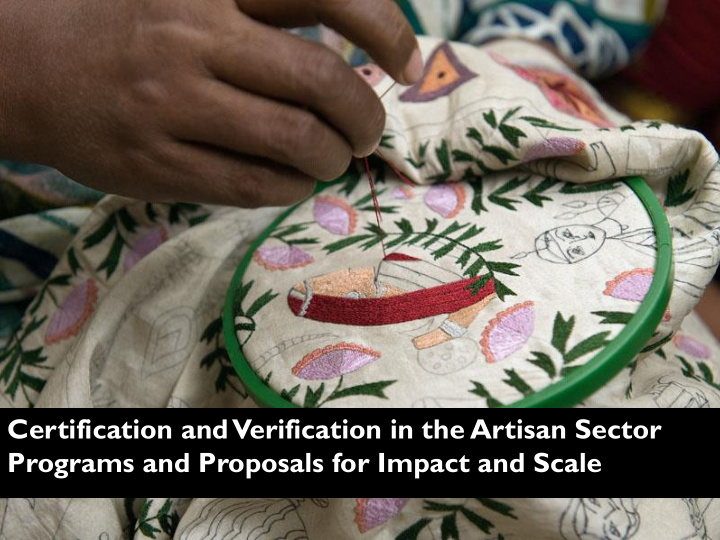



Certification and Verification in the Artisan Sector Programs and Proposals for Impact and Scale
Panelists Abigail Jacobs and Doug Guiley west elm Indrassen Vencatachellum Formerly of UNESCO Moderated by: Karen Gibbs Alliance for Artisan Enterprise
Certification: Best Practices and Pitfalls Originally presented by Global Goods Partners What are the key questions and considerations for creating new or evaluating existing certification systems?
Key Considerations • Scope • Monitoring • Fee Structure • Transparency • Consumer Value • Accessibility • Consumer Awareness • Governance • Compliance
Scope What does the certification do and not do? Lack of recognition/awareness and confusion around what “sustainable fishing” entails
Transparency Is information clearly communicated and publicly available? From Consumer Reports’ www.greenerchoices.org
Accessibility How do you create a system that is accessible to a range of businesses? http://www.marcgunther.com/a-schism-over-fair-trade/ http://www.npr.org/blogs/thesalt/2013/04/24/177757797/coffee-for-a-cause-what-do-those-feel-good-labels-deliver http://www.fairtradeusa.org/sites/all/files/wysiwyg/filemanager/standards/FTUSA_MAN_CertificationManual.pdf
Governance How do you ensure third-party independence when the certification agency is supported by brands? Handles compliance and audits for Fair Trade USA, MSC, FSC, and more… • Financial independence • Fee-for-service independent of volume • Conflict of interest policy and structure http://www.nytimes.com/2013/06/01/us/complaints-abound-in-green-certification-industry.html?ref=johnmbroder&_r=1&
Compliance How do you create a compliance system that is trustworthy? • Self Assessment • Peer visit • Monitoring audit • What happens to those found in violation? http://www.greenerchoices.org/eco-labels/label.cfm?LabelID=239
Monitoring How do you create a monitoring system that is not too costly or onerous? • Self Assessment: every 2 years, audit every 2- 6 years depending on the risk category, peer visits every 2 - 6 years depending on the risk category • 12 fee-based professional agencies perform analysis • Audited annually • Logo and labels are free with certification • Audits performed every three years by an independent agency • Application with fee, document request and onsite audit, evaluation audits in year 0, 3, 6, and surveillance audit year 1-2 and 4-5 http://online.wsj.com/article/SB10001424052702304299304577349731690704306.html
Fee Structure Audit Fees every six years of estimated $3,000 +, and nominal fees every three years Annual membership fees to the CCIC and a one-time licensing fee, based on the company's gross annual sales, required for use of the trademarked logo ($500 to $4,500). http://www.greenerchoices.org/eco-labels/label.cfm?LabelID=239
Consumer Value Measurable/observable return on investment or personal benefits Consumer education, brand awareness and outreach are key Point of sale signage reinforces certification message
Consumer Awareness Consumers seem to be most familiar with seals sponsored by federal agencies and that represent frequently purchased items Energy Star (87%), Recycling (89%) and USDA Organic (62%) Consumers seem to be least familiar with seals sponsored by non- governmental organizations and infrequent purchase Cruelty-free/Leaping Bunny (11%), Marine Stewardship Council (11%) and Forest Stewardship Council (6%) Source: BBMG, “Conscious Consumer Report 2009.”
Consumer Awareness Consumers seem to be least familiar with seals sponsored by non- governmental organizations and infrequent purchase Cruelty-free/Leaping Bunny (11%), Marine Stewardship Council (11%) and Forest Stewardship Council (6%) Competing Standards: Only 37% of • • Sustainable Forestry companies who are Initiative, Rainforest certified license and Alliance use the logo • Reluctance towards • Competing, less strict use (Home Depot & standards IKEA) • Major cosmetic Infrequency of • producers are not purchase eligible for certification Source: BBMG, “Conscious Consumer Report 2009.”
Recommend
More recommend